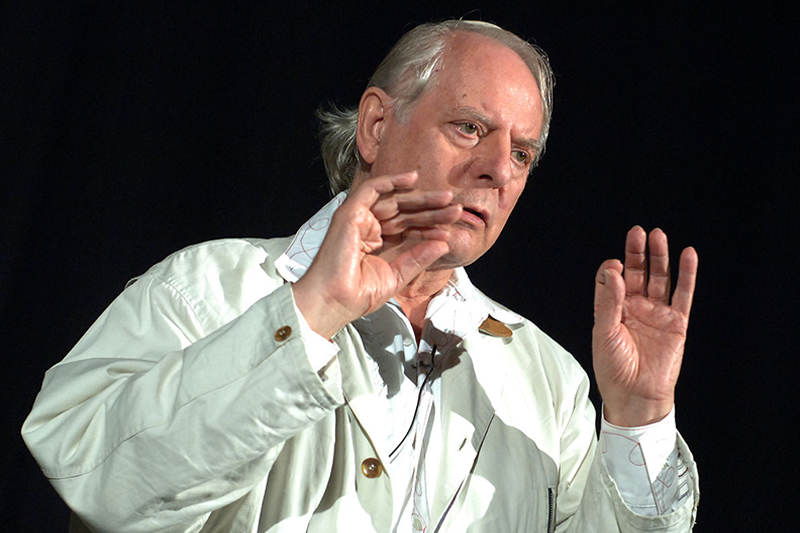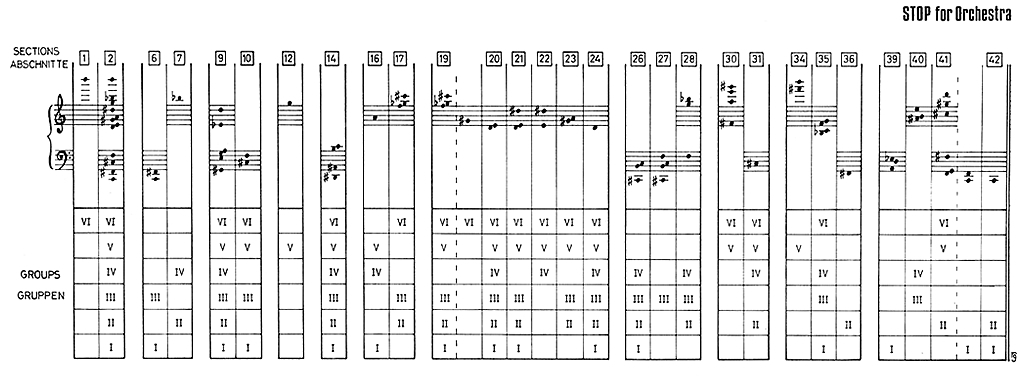
Instrumentation Works for Orchestra
Stockhausen Complete Edition on CD
Since 1991, a complete edition of all recordings in which Karlheinz Stockhausen has personally participated is being released on compact discs. Each CD in this series is identified by Stockhausen's signature followed by an encircled number. The numbers indicate the general historical order of the works.
Stockhausen realised the electronic music and participated in these recordings as conductor, performer, sound projectionist, and musical director. He personally mixed down the recordings, mastered them for CDs, wrote the texts and drew the covers.
- The compact discs may be obtained from the Stockhausen-Verlag: Kettenberg 15, 51515 Kuerten, Germany (www.stockhausenCDs.com).
Karlheinz Stockhausen
Instrumentation Works for Orchestra
STOP for orchestra
The conductor is to divide the orchestra into six characteristic groups of mixed instruments  -
-  . This division is to be made with reference to the Prescribed Pitch distribution (see score):
. This division is to be made with reference to the Prescribed Pitch distribution (see score):
Each group must have instruments able to play the pitches given to it (not all instruments in a group
need to be able to play the pitches in a section).
The number of instruments in the different groups should be approximately equal. If instruments
from the same family appear in several groups, they should be different in timbre: for example with
three flutes, one group should have only piccolo, the other only flute, the third only alto flute;
with trumpets and trombones, one group only with straight mute, another cup mute, another wawa
mute; with horns, one group only open, the other only stopped; with strings, one group only normal,
another sul tasto, another sul ponticello, etc......
Each group plays only when its numeral appears in a section and in all TUTTI.
SOLI: instrument(s) are to be determined by the conductor, taken from any group; they are to be conducted.
The six groups should be spatially as far apart from one another as possible.
All pitches sound as written. An accidental applies only to the note before which it stands (except SOLI in 39).
There are 6 parts, one for each group of instruments. The parts have staves without pitches. After the conductor has chosen the instruments for each of the 6 groups, a part for each instrument must be prepared, containing the pitches it can play, transposed where necessary. The same applies to the SOLI. (Compare material for the "Paris Version".)
The score is divided into 42 numbered sections. The duration of each section is given in time-units of relative duration, for example ← 8 →. The value of 1 time-unit should lie around 1/40 minute and remain the same throughout one performance. The conductor should indicate the duration of each section with a slow motion of his arm (for example, in a half circle, like the hands of a clock, or by slowly raising one arm).
Each section contains indications for various parameters:
| tempo: | SLOW FAST ACCEL RIT |
| rhythm: | REG = REGULAR (periodic) IRR = IRREGULAR IND = INDIVIDUALLY (each player for himself) SYNCH = SYNCHRONOUS (conductor gives each beat) |
articulation: = repetition of the same pitch
 = tremolo with two pitches
= tremolo with two pitches

 = continuous transition to
= continuous transition to
STACC = staccato
LEG = legato
CONT = continuous (held) tones
Wherever indications for tempo, rhythm or articulation are omitted, each instrumentalist should
play a mixture of several tempi, of regular and irregular rhythms, or of legato, portato, staccato.
pitches:
Each player chooses from the given pitches, starting with any and changing in any
order, unless otherwise prescribed.
